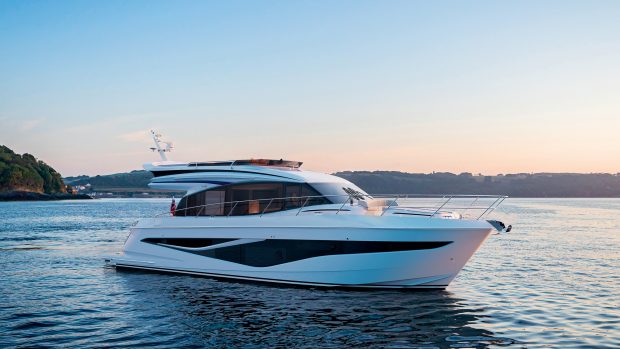British sailing boat manufacturer RS plans to revolutionise the RIB market with its battery-powered Pulse 58
The race to build the first mass market electric boat is hotting up with brands like RAND, X-Shore, Frauscher, Nimbus, DutchCraft and Avon all competing for the potentially lucrative prize. However, a radical new entry from British dinghy manufacturer RS Sailing could yet pip them all to the post.
The Pulse 58 is a pure electric RIB that uses proven automotive components matched to a revolutionary new drive system in a lightweight recyclable hull to steal a march on its competitors in terms of efficiency, sustainability and, crucially, price. Whereas most of its rivals cost upwards of €200,000, the all-new RS Pulse 58 costs less than half that at €99,950.
As the name suggests the Pulse 58 is a 5.8 metre (19ft) RIB that at first glance looks much like any other but one peak at the stern tells a very different story. Where you’d expect to find a substantial petrol outboard is an empty transom topped by a small lip just a few inches above the surprisingly high deck.

RAD’s hubless rim drive is safer and more efficient giving a claimed 35nm range at 20 knots
The mystery deepens when you peer under the hull to be confronted by a circular hoop with four pink blades jutting inwards. This is the revolutionary RAD drive that is key to the Pulse’s range and efficiency. RS claims it has a range of at least 35nm at 20 knots or considerably further at slower speeds.
Although RS admits this isn’t as far or as fast as an equivalent petrol powered craft, it also points out that research indicates very few 6m RIB owners regularly exceed this range in daily use and most spend around 70% of their time at displacement speed.
The idea for the Pulse 58 began to take shape in 2017 when Alex Newton-Southon, CEO of Design and Technologies at RS Sailing, started to look at new ways of growing the business.
Article continues below…

X Shore Eelex 8000: Could this electric boat become the Tesla of the seas?

740 Mirage: Frauscher launches electrifying new sportsboat
RS is already the world’s largest manufacturer of small sailing boats and dinghies, building over 3,000 craft a year at four different sites across the UK so diversifying into the burgeoning power boat market seemed like the natural step but only if it fitted the company’s sustainable boating ethos. An all-electric RIB built using a blend of natural fibres and recycled materials suited the profile perfectly.
Natural fibres
The Pulse 58 is the result of two years’ research and development to find a hull form, drivetrain and build process that met these targets. It features a cathedral-style hull with an unusually long, slim central section to minimise drag, and tunnels either side to provide stability.
The deep central section also houses the battery pack to keep the centre of gravity as low as possible. All three sections flatten off at the stern to promote fast, efficient planing. Hypalon tubes complete the package while a modular self-draining deck adapts to fit a range of different helm and seating layouts.

The battery pack is from a Nissan Leaf
The hull is moulded using a combination of 40% basalt rock, 30% natural flax and 30% glass fibres infused with a 26% bio epoxy around a PET core made from recycled plastic bottles. It’s a tried and tested process developed by RS for its sailing boats and said to be just as strong as conventional GRP but more easily recyclable at its end of life.
The drivetrain is built around the same 57Kwh lithium ion battery pack used in the Nissan Leaf electric car but marinised and sealed inside a waterproof box with its own integral fire extinguisher. Water passing the hull keeps it cool and it’s charged overnight using a standard 240-volt mains or shorepower plug.
A faster two-hour charger is optional where 3-phase power is available. The batteries are warranted for two years and 2,000 cycles but should last for five years – many Nissan Leafs have clocked up more than 150,000 miles in that time.

Fully integrated helm gives detailed info on remaining charge and real-time range
The RAD drive is perhaps the least proven element of the Pulse but also its most exciting. Its hubless rim drive is claimed to be more efficient than a conventional propeller at speeds up to 25 knots due to reduced tip losses and more effective transmission of the electric motor’s high torque characteristics.
It’s also safer and less likely to get fouled by ropes or sails than an exposed propeller, an important feature when used as a club or safety support boat. The whole rim swivels to steer and pivots up behind the transom for trimming, beaching and trailing.
Two small electric motors deliver power to the rim (providing a degree of built-in redundancy should one fail) via a belt drive. If you do accidentally ground it or hit something hard, a sheer pin allows the whole unit to pivot up rather than snap off.

Cathedral hull provides stability and efficiency
Bright future?
The Pulse 58 is a brave new entry to an increasingly contested market but RS says it has been overwhelmed by the positive reception at the 2020 Düsseldorf boat show with enquiries from sailing clubs, marinas, superyacht owners and leisure boat users. It hopes to build 50 boats this year with deliveries starting in October and 100 boats in 2021.
The 58 will be followed by both a 4.2-metre Pulse tender and an as yet unnamed larger model. If it hits those numbers RS could yet become the first builder of a truly successful mainstream electric sportsboat.
First published in the April 2020 edition of Motor Boat & Yachting.









